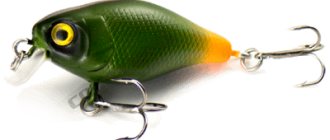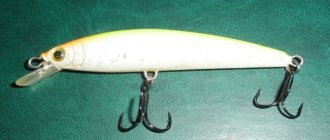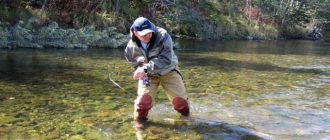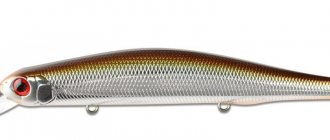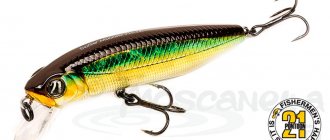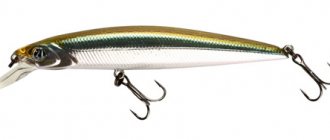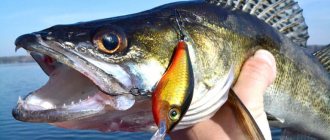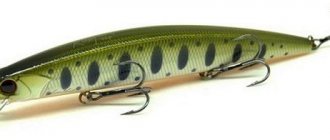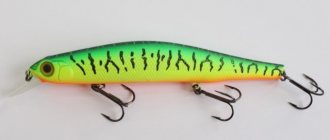Shad wobblers are a class of voluminous spinning lures, the name of which comes from the name of the American fish of the same name from the herring family. Unlike other classes of bait, shad wobblers have a high body with flattened sides. In their shape, shad are similar to many species of fish living in the reservoirs of our country: crucian carp, roach, perch, and silver bream. Shad-class wobblers are great for catching a wide variety of predatory fish in a variety of conditions. The versatility inherent in shad makes them excellent search baits. Let's talk about shad wobblers in more detail.
Origin
The name of the shad class of wobblers comes from the name of a fish of the herring family called the American shad, the name of which in turn comes from the Old English word “sceadd”, meaning “herring”.
American shad is a large fish reaching a length of more than 70 cm and a weight of up to 8 kg. The American shad originally lived in the waters of the Atlantic Ocean from Newfoundland to Florida. At the end of the 19th century, fertilized eggs were released into the Sacramento River and subsequently spread along the entire Pacific coast of North America from Southern California to Cook Inlet and Kodiak Island in Alaska.
American shad is a valuable food fish; this fish was one of the most important fisheries among the Indians and the first European settlers of America. At one time, American shad were caught in almost every river on the Atlantic coast of America.
To breed, American shad enter the rivers of North America, rising up to 700 kilometers upstream to spawn. The female lays from 30 to 600 thousand eggs. Juvenile shad stay in rivers until autumn, and in autumn, having reached a length of 4-11 cm, they slide into the sea. While numerous shad fry remain in the river, they are the main food supply for most species of American predatory fish.
Appearance of shad wobblers
Wobblers of the shad class, like the live prototype on the basis of which they were created, have a high body and slightly flattened sides. Visually, the shad wobbler looks like a large, well-fed, well-fed fish. Such prey seems more satisfying and appetizing to predators.

Some shad wobblers in their appearance are transitional forms between the shad wobbler and the minnow wobbler, as well as between the shad wobbler and the crank wobbler. This is done either to make the wobbler more realistic and similar to a real natural prototype, or to ensure that the shape of the wobbler better suits certain fishing conditions.
Most shad wobblers have a body length from 40 to 70 mm, weight up to 12 grams. These sizes are optimal for catching most of our predators: pike, perch, pike perch.
The coloring of shad wobblers can be very diverse: from muted matte natural colors to bright acidic ones, each angler will be able to choose a wobbler to suit his needs and fishing conditions. On the body of most shad wobblers, scales, fins, and eyes are clearly drawn. Many shad wobblers have a black dot or a series of dots at the head of the wobbler; this is a tribute to tradition; these are exactly the kind of dots that the living prototypes, the American shad, have.
Features of shad wobblers
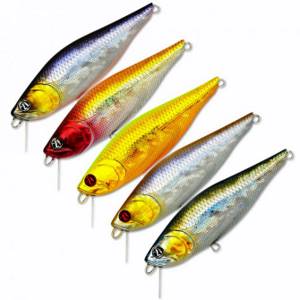
Shad wobblers have their own characteristics that distinguish them from other types of wobblers; the angler must take these nuances into account when fishing:
- Shed wobblers, unlike minnow wobblers, have a pronounced game of their own, with vibrations of high or medium frequency. Due to the presence of their own game, they effectively catch fish on a uniform retrieve.
- Shed wobblers, unlike crank wobblers, work not only on uniform, but also on jerky retrieves. Shed catch fish effectively when twitching and stopping-and-go.
- When jerking, the shad sways with its whole body, and when pausing, it takes a position close to vertical, due to the center of gravity of the bait, located close to the front of the wobbler. Jerk fishing is especially effective when fishing for pike and pike perch.
- Floating shad wobblers can be successfully floated downstream; to do this, after casting the wobbler, do not close the reel bail, allowing the current to pull the wobbler another few tens of meters.
- A shad wobbler is better suited for fishing in strong currents than a crank or fat wobbler. Due to its less wide profile, the shad provides an optimal, not too intense vibration, which effectively provokes a predator to attack the bait, unlike a fat or crank, with their too strong vibration.
- When fishing at dusk, shad have greater visual visibility in the water, which leads to more attacks by predators on the wobbler.
- Most shad have high tensile strength when retrieved, so they require appropriate spinning rod when fishing with them.
Degree of buoyancy
Shad wobblers are divided into three groups according to the degree of buoyancy: floating, sinking and suspenders (wobblers with neutral buoyancy).
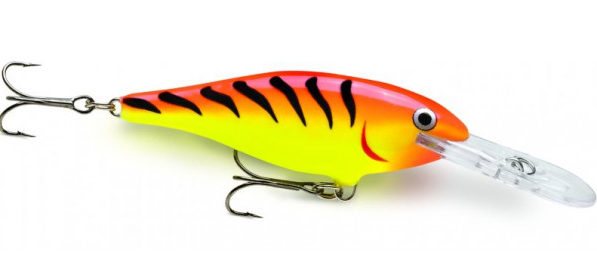
Usually, the marking of a wobbler contains special letters that indicate the degree of its buoyancy:
- F – floating, floating shads. When retrieving, the floating shad wobbler is buried to a certain depth, and when the reeling stops, it floats up. With floating wobblers, shad can be caught both in deep areas of the reservoir and in shallow water. It is convenient to use a floating wobbler to bypass various underwater obstacles: dense bottom vegetation, snags or bottom debris, pausing in the retrieve. Floating shad wobblers can be floated downstream, thereby significantly increasing the fishable area of the reservoir.
- SP – suspending, shads with neutral buoyancy A suspended wobbler can suspend in the water column, which floating and sinking wobblers cannot do. The suspender is capable of provoking the fish to attack during a pause. The jerks produced by the fisherman during jerking retrieves attract the attention of a predator at a great distance. After the jerk there is a pause, this is what gives the predator the opportunity to attack the bait. In addition, during a pause, the wobbler makes small damped oscillations, which additionally provoke the fish to attack the bait. A shad wobbler with neutral buoyancy most often has more weight than a floating wobbler, and therefore has better flight characteristics. Wobblers with neutral buoyancy (suspenders) do not sink or float in the water; they seem to be suspended. Shads with neutral buoyancy are effective when catching sluggish, sluggish fish. When a wobbler runs for a long time along a given horizon, even a well-fed predator decides to attack.
- S – sinking, sinking shad. Most often, sinking shad wobblers are used in strong currents, when you need to drive the wobbler to a certain fishing horizon and keep it there, while maintaining proper play. Sinking minnows have decent weight, therefore they have the best flight characteristics compared to wobblers of other types of buoyancy. It is very convenient to use sinking shad when exploring large areas of an unfamiliar body of water. The wobbler is cast over a long distance, driven in a high-speed style, the active predator rushes after the bait running away from it. It is convenient to catch shad in clear water with a sinking wobbler. When a shad wobbler sinks, it resembles a sick fish, and such a weakened fish seems like easy prey for any predator.
You may be interested in: Pike
For an angler fishing for shad with a wobbler, it is important to choose the right wobbler for specific fishing conditions. The choice of a wobbler based on the degree of buoyancy depends on many factors: the depth of the reservoir, the presence of underwater vegetation and snags at the bottom of the reservoir, and also at what depth the predator is located. For example, you should not use sinking wobblers in reservoirs where there are a large number of snags at the bottom.
What is considered a wobbler?
First, let's figure out what kind of bait should be considered a wobbler. To a first approximation, a wobbler is a bait with a voluminous body made of plastic or wood. But this description also includes poppers, walkers, jerkbaits, and rattlins - in general, baits that are related to classic wobblers, but at the same time are not them.
Therefore, you should pay attention to another design feature that every classic wobbler has - this is a blade, or a bevel of the head part that replaces it (for example, in the Ima Sasuke wobbler). The blade is located in the front part. There are wobblers with a rear blade (for example, Megabass and Shore Impress), but they are not classic, and deserve a separate article.
Thus, we have compiled a “portrait” of a classic wobbler. But still, their diversity makes you think seriously when choosing. Of course, the differences between wobblers make it possible to classify them. Let's figure out how this can help us.
Classification by body shape
Even a person who has nothing to do with fishing will notice at first glance at wobblers that they are not the same in shape, and sometimes differ significantly. Among all the diversity, the following subclasses can be distinguished:
- Minnow wobblers. “ Minnow
” in English means “little one.” They have an elongated shape, similar to a sticker or a ballpoint pen. Typical representative: Rapala Original. - Shad wobblers. “ Shad
” translated from English means “herring.” These wobblers are thicker, the body shape is closer to a roach. Typical representative: Rapala Shad Rap. - Fat wobblers. " Fat
" - "fat man". They have a round, almost spherical body, hardly reminiscent of any inhabitant of our reservoirs. Typical representative: Rapala Fat Rap. - Various wobblers that do not belong to the previous three categories. This primarily includes various imitations of insects and frogs.
Fats usually have the most powerful game. Their time is summer, when the predator is active. Small models are favorites for chub, as well as perch. Shads and minnows are more versatile.
According to the activity of your own game
The blade, which is available in one form or another for every classic wobbler, is designed to perform two functions - to ensure the depth of the wobbler and to give it play. However, it often happens that having bought a wobbler, a novice spinning angler discovers that the bait plays very weakly, or even drags along without playing at all. What is this, marriage? The fisherman can curse in his heart both the manufacturers who released such a “monster” and the store clerks who sold him on for a lot of money... And at the same time, he will not be right.
So, two classes of wobblers should be distinguished:
- Wobblers that have an active game of their own
- Wobblers that are supposed to be animated by the fisherman
With the first ones, everything seems to be clear - I threw it, dragged it, caught it. What about the second ones? These include models without any game at all, or with an insignificant game of their own. These wobblers imply a jerky retrieve, which transforms their behavior in the water, making them extremely (by an order of magnitude!) more catchy in most situations than conventional, playing wobblers. Using a jerky wobbler you can tempt a predator into a total lack of bite. Wiring should be done in short jerks, with periodic pauses. Usually the rule applies - the more active the bite, the faster the retrieve, the shorter the duration of the pauses.
By the way, I would like to note that various options for uneven wiring are generally much more effective than monotonous wiring, and they can be used with actively playing wobblers - here the matter is limited only by your imagination.
As a rule, minnows have a weakly expressed game, less often - shads. On the boxes of jerking wobblers you can sometimes see the words “jerk”, “twitch”. An indirect sign is “scapula”. The smaller it is, the less actively the wobbler plays.
According to the degree of buoyancy
Buoyancy is indicated in the characteristics of the wobbler. It is worth noting that this parameter is also ambiguous - for example, one pops up like a cork, the other slowly. But most modern manufacturers indicate buoyancy quite accurately. In addition, it can be adjusted - using special self-adhesive weights, by installing tees made of thinner or thicker wire, and so on.
- Floating wobblers. Floating
is indicated on their packaging , or the letter F is present in the model marking, for example, Zipbaits Rigge 35F. - Wobblers with neutral buoyancy, so-called suspenders. Can be distinguished by the inscription Suspending
on the packaging, or the letters SP in the labeling. These wobblers have a specific gravity equal to the specific gravity of water, and therefore, when the wiring stops, they do not float or sink, but freeze. It should be noted that the use of a leash often turns such a wobbler into a slowly sinking one. To avoid this, you should abandon additional elements such as swivels, and also remove the winding ring from the nose loop of the bait. - Sinking wobblers. They are labeled as Sinking
or S. Here we can distinguish a subcategory - slowly sinking. These are designated Slow sinking, or SS. But not all manufacturers indicate this.
As for the choice of buoyancy, floating and neutral wobblers are most optimal for a novice fisherman. The floating one can be held over obstacles, allowing it to float up. When fishing on a river, you can float it to an interesting and hard-to-reach point, and also hold it there for some time. The suspender is optimal for wiring with pauses. Hanging in the water column, it perfectly provokes fish to attack. The advantages of sinking wobblers are, firstly, the ability to immediately sink the bait to a certain depth, and secondly, they are still somewhat heavier than their floating and neutral counterparts, and therefore fly further. A slowly sinking wobbler also works well on a pause.
Deepening
Wobblers differ in several classes according to the degree of depth. The depth of the wobbler tells the angler how deep from the surface of the water the wobbler will be when the angler reels in the fishing line.

According to the depth at which the wobbler operates, shads are divided into several groups:
- SSR - Super Shallow Runner
, super shallow-water wobblers, working depth is literally a few centimeters. As a rule, shad wobblers of this group have positive buoyancy and are designed for fishing in heavily overgrown areas of reservoirs, when there are literally a few centimeters left from the surface of the water to the grass, in which the wobbler is inserted. - SR - Shallow Runner
, shallow wobblers, working depth 0.3-0.5 meters. According to the degree of buoyancy, they can be either floating, sinking or suspending. SR class shad are effective when fishing shallow water areas, coastal areas and shallows, especially in the summer, where the bulk of the fry is concentrated at this time of year, and where the fry is, there is a predator. The most versatile of all wobblers, suitable for most fishing conditions. - MR - Medium Runner
, medium depth, working depth up to 1.5 meters. Shads with such depth catch pike and pike perch well. Pike are caught well when moving a wobbler along the grass, as close to the vegetation as possible. Shad wobblers give good results on large bodies of water, when guiding along a riverbed or bank edge; the catch here can be both pike and pike perch. - DR - Deep Runner
, wobblers with a high degree of penetration, working depth 1.5-2.5 meters. Deep-sea minnows allow you to fish channel edges and local holes in large and deep reservoirs. Due to their working depth, deep-sea shads in these conditions make it possible to qualitatively fish such places and can give a very good catch. - DD - Deep Diving
, baits that go as deep as possible, working depth is more than 2.5 meters. Used for catching perch, pike and pike perch at great depths.
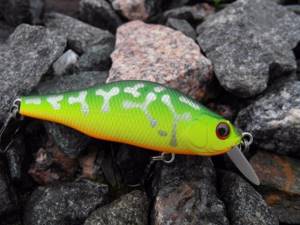
Manufacturers indicate on the packaging of the wobbler its working depth in meters or feet, as well as the degree of its buoyancy. The fisherman should pay close attention to these parameters when choosing bait in the store.
The correct choice of wobbler in terms of depth is the basis for successful fishing and a decent-sized catch. A wobbler that is incorrectly selected in terms of depth or completely ignoring this parameter when fishing leads to fruitless fishing.
Size

The sizes of shad wobblers are comparable to the sizes of other types of wobblers. Based on size, shads can be divided into three groups:
- Ultralight class shad - wobbler weight up to 5-7 grams, length up to 5-7 cm. Shads of this size are used for catching perch, chub, and ide.
- Medium-sized shad - wobbler weight up to 12–14 grams, length from 7 to 12 cm. The most common size for shad wobblers; with a wobbler of this size you can catch pike, large perch, asp and pike perch.
- Minnow is large in size - the weight of the wobbler is over 12 grams, the length is from 12 cm and above. Used for catching trophy size pike and catfish.
Shad wobbler color
The color of the wobbler plays a lesser role than the correct selection of bait for the fishing conditions and the correct wiring.
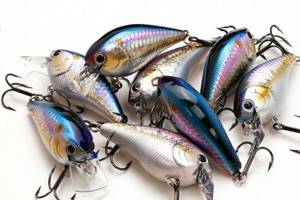
The colors of shad wobblers can be divided into two large groups: shad wobblers with natural colors (similar to the natural colors of real prey of predators) and shad wobblers with fancy colors (bright colors that provoke the predator to attack).
Many wobblers have a holographic coating on the surface of the body, which increases the attractiveness of the bait to a predator.
Many fishermen adhere to this tactic when choosing the color of a wobbler. In an unfamiliar place, first try shad of natural colors; if there is no interest in them on the part of the predator, you can try to catch them with wobblers of provocative colors.
You may be interested in: Boat motors: 15 best motors in terms of price-quality ratio
Review of the best wobblers for pike
In summer, you should take floating wobblers that can pass over aquatic vegetation, provoking the pike to emerge from it. The second important aspect when choosing a wobbler for pike is the size of the bait. The most popular models are 5-15 cm long. Efficiency also depends on the color of the bait.
When choosing a color, you need to take into account the time of day in which you plan to fish, as well as the characteristics of the reservoir, the level of water transparency, etc.
It is worth noting that most wobblers from reputable companies have an informative description that explains where and under what conditions a particular wobbler will show the best result. You can study the wobblers you like in more detail in various online stores.
It is worth giving preference to highly specialized sites that trade specifically in wobblers, for example Rapala, Yo Zuri, Megabass.

Noise effects and long-distance casting system.
Shads, due to their flat shape and therefore poor aerodynamics, do not have the best flight qualities, so it is recommended to purchase shad wobblers equipped with a long-distance casting system.
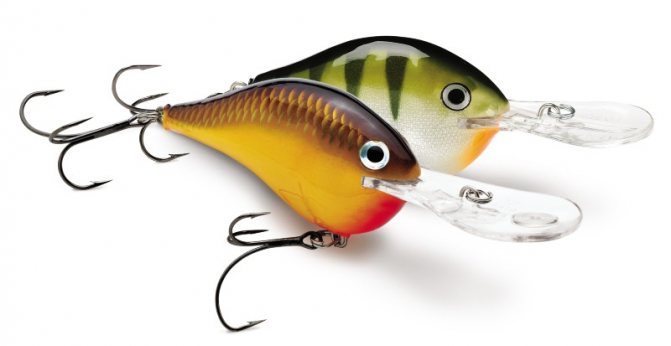
The long-casting system may have different names from different manufacturers; it is a channel inside the body of the wobbler along which the weight moves. In the normal state, the weight is held by a magnet in the front part of the channel; when casting, the weight is detached from the magnet and shifted to the tail of the bait, thereby shifting the center of gravity of the wobbler, which increases the range and accuracy of the wobbler's flight. After the wobbler falls into the water, the weight is again fixed with a magnet in the front part of the channel, without interfering with the play of the wobbler.
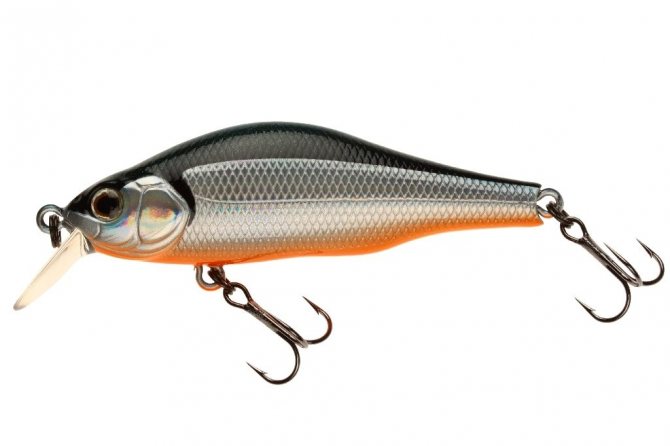
Many shad wobblers have noise chambers built into the body, inside which balls of metal or other material are placed. When the wobbler moves underwater, the balls move inside the noise chamber, creating an additional acoustic effect that attracts predators. Shads with noise chambers work well in murky water or when you need to lure a predator out of ambush.
Colors
The color schemes of modern Shad wobblers are perhaps the richest among all classes of wobblers. You can find natural colors like small fish, with full details of scales, eyes, and fins; acidic, bright wobblers; matte dark tones; coatings with the effect of multi-reflection of light; contrasting two-three-color wobblers.
The color of the bait is sometimes crucial. If the water is cloudy, the shad should be bright; if the water is clear, they should be more natural. In muddy water and poor lighting, a predator will pay attention to a noisy and “juicy” wobbler, while in daylight in clear water, the tapping of the balls and the “screaming” shade can be frightening.
Wiring wobblers
Retrieving refers to the actions of a fisherman, performed by him with the help of a reel and a rod, which force the bait to move in the water at a certain speed and along a certain trajectory, with its movements reminding the predator of a food object.
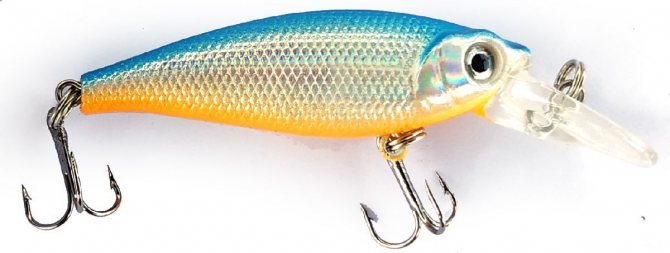
Shed wobblers work with a variety of types of wiring. Fat wobblers, in the vast majority of cases, work on a uniform retrieve; twitching with them turns out to be clumsy and ineffective. Minnow wobblers, on the contrary, work on a jerky retrieve, but are ineffective on a uniform retrieve. Sheds occupy a sort of intermediate position between these two classes of bait.
Shed wobblers work both on a uniform retrieve, like a fat wobbler, and on a jerky retrieve, like a minnow wobbler.
Uniform wiring
Uniform wiring is the simplest and most common type of wiring. Uniform wiring is created by constant rotation of the coil. The rod is not involved in wiring. With a uniform retrieve, the angler can only change the retrieve speed.
Jerk wiring
Jerk retrieval is the retrieval of the bait, which is carried out using the movements of the rod. The bait in the water moves jerkily, reminiscent of the movements of a weak, wounded fish. Jerking movements can tempt even a passive predator to attack.
Twitching
Twitching is a set and mixture of a wide variety of jerking wiring. When twitching, a combination of various stretches, jerks and pauses is used to attract the attention of the predator and provoke it to attack. Twitching is carried out using sharp and smooth movements of the rod.
Stop and go wiring
Stop & Go wiring is intermediate between uniform and jerking wiring. It is carried out by rotating the reel handle, which alternates with pauses. The “stop and go” wiring forces the wobbler to move underwater and hover in place, which well provokes a passive predator to attack the bait.
The best surface wobblers and non-hooking wobblers for pike
Poppers belong to the class of surface wobblers. These are exclusively summer wobblers, that is, baits that are not used at other times of the year. You can read about the best poppers here. You can safely add River2Sea Bubble Popper to the top from that article. According to many spinning anglers, it is one of the best and catchiest surface wobblers for pike. And in terms of sales dynamics, it is perhaps the most popular. Through the slots, the bait releases additional “bubbles”, which attracts the predator.
the secret of catchability
Even a slight movement of the tip of the rod brings the bait into working condition - it gurgles and raises fountains of spray.
It’s up to you to decide which wobblers are best for pike in the summer, but we can’t help but say about less common species. Non-hook wobblers are not so popular. They are designed for fishing in water lilies. Since the hook is secured, snags are minimized.
plus and minus
The main “disadvantage” of non-clutches is that derailments happen frequently. Homemade non-snacking wobblers are used as scouts.
After a single hit, any catchable wobbler with tees is placed, and the pike attacks it. An example of a non-hooking design is RAPALA WEEDLESS SHAD. Works on fast uniform wiring. During the pause, he goes into a tailspin. There is an opinion among fishermen that this is more of a rattlin. The manufacturer positions it as a non-hooking wobbler.
For skilled fishermen, we suggest watching a video on how to make homemade wobblers for pike fishing: you can make the most budget option with your own hands, but you will have to work to maintain the balance and not damage the aesthetics.
The best shad wobblers
Wobbler Rapala Shad Rap
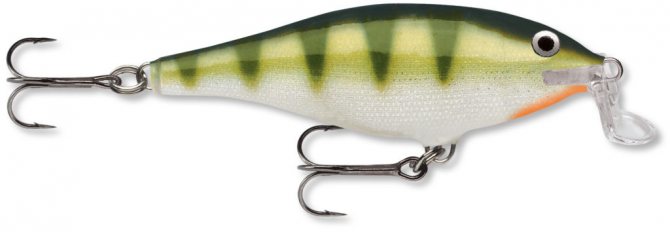
Wobbler Rapala Shad Rap is a phenomenally catchy wobbler from the world famous Finnish company Rapala. The wobbler perfectly catches pike, large perch, pike perch and catfish. The shape of the Rapala Shad Rap wobbler is a classic shad. In its appearance, the wobbler resembles the small fish that live in our reservoirs: perch, crucian carp, silver bream, roach, rudd or ruff. Wobbler Rapala Shad Rap is a floating deep-sea wobbler with a maximum diving depth of up to 4.5 meters. The wobbler is designed for fishing bottom areas of a reservoir, holes, whirlpools, deep drops and edges. The wobbler is available in four sizes - 5, 7, 8 and 9 cm, weighing 6, 8, 11 and 15 grams, respectively. The wobbler works both with uniform wiring and with twitching.
Wobbler Pontoon21 Bet-A-Shad
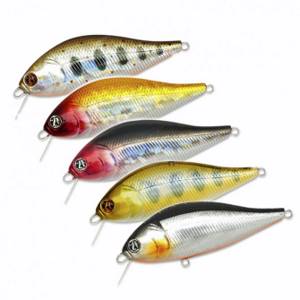
The Pontoon21 Bet-A-Shad wobbler is designed for catching a predator hidden in underwater vegetation, in places with dense bottom vegetation, with wiring over it. It can be used both with uniform wiring, as it has its own active game, and with jerking. The Pontoon21 Bet-A-Shad wobbler is available in both a floating and suspended form, in three sizes: 63, 75 and 83 mm. Bet-A-Shad is designed for fishing in shallow areas of reservoirs, with a maximum immersion of up to 40 cm. The wobbler has a long-casting system and is equipped with high-quality Owner hooks.
Wobbler Yo-Zuri Duel Hardcore Shad
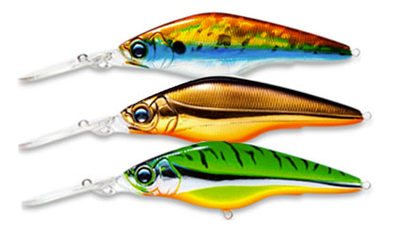
Wobbler Yo-Zuri Duel Hardcore Shad is a shad wobbler produced by the Japanese company DUEL, well known to anglers all over the world. The wobbler is well suited for catching perch, pike perch and pike, both with a spinning rod using a uniform retrieve and twitching, and by trolling. The wobbler has a magnetic long-casting system MWT, noise chambers of different frequencies and textured coloring with a holographic effect. The wobbler is a suspender in terms of buoyancy. The wobbler is available in three sizes - 50, 60 and 75 mm, weighing from 3.5 to 10 grams.
Wobbler Rapala Shallow Shad Rap
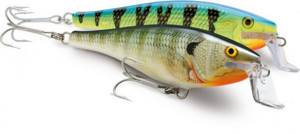
The Rapala Shallow Shad Rap Wobbler is a version of the Shad Rap Wobbler designed to work at shallower depths. The wobbler works both with uniform wiring and twitching. Wobbler Rapala Shad Rap is a floating wobbler with a maximum diving depth of 1.8-2.4 meters. The wobbler is available in four sizes - 5, 7, 8 and 9 cm, weighing 5, 7, 9 and 12 grams, respectively. Wobblers 5 and 7 cm long are suitable for catching perch and trout. Wobblers 8 and 9 cm long are suitable for catching pike perch, pike, brown trout or salmon. The wobbler works both with uniform wiring and twitching.
You may be interested in: Wobblers for pike
Wobbler Megabass Diving Flap Slap
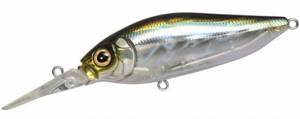
Megabass conducted a large series of studies and tests in the field of hydrodynamics when creating bladeless wobblers of the Vibration-X series, a by-product of which was the creation of the Megabass Flap Slap wobbler. In 2006, as a result of further improvements and modifications: increasing the blade and reconfiguring the internal balancing, a deeper-water wobbler Megabass Diving Flap Slap was created.
The main difference between the Megabass Diving Flap Slap and other shad wobblers is the ability to swing powerfully with its sides, 2-4 oscillations between jerks; in addition, when jerking, it turns well and falls on one side or the other. The game of the wobbler resembles the movement of the head when slapped in the face. The Megabass Diving Flap Slap wobbler has neutral buoyancy and is available in one size: wobbler length 77 mm, weight 10.6 grams, working depth 1.5-2 meters. The wobbler works both with uniform wiring and with twitching. The following fish are well caught using a wobbler: pike, perch and pike perch.
Wobbler OSP High Cut
The OSP High Cut wobbler was created by the world famous Japanese company OSP. According to its properties, OSP High Cut is a shad wobbler with the habits of a minnow. The bait is designed for catching wary fish in pressed-in reservoirs with clear water. With a working depth of 2.0-2.5 meters, OSP High Cut is located below the working horizon of minnow wobblers of the Asura-Varuna-Rudra family, and slightly above the working horizon of deep cranks and shads Dunk, Power Dunk, Blitz MAX DR.

The wobbler is suitable for both uniform and jerky retrieves. The length of the OSP High Cut wobbler is 60 mm, there is a floating version weighing 5.1 grams and a suspended version weighing 5.3 grams. The wobbler is made silent, has a body made in the form of a honeycomb structure, and therefore is lightweight. There are 7 different colors in the model range.
Wobbler Kosadaka Mirage
Kosadaka Mirage wobblers are a family of shad-type wobblers, copies of the well-known Japanese wobbler Zipbaits Khamsin. The Kosadaka Mirage wobbler has all the properties typical of shad-type wobblers. They have an active game of their own, so they allow you to catch even with a uniform retrieve, during which they sway and sparkle with their sides. Wobblers perform well when twitching and allow the use of fairly long pauses. Wobblers have positive buoyancy, long-distance casting systems and noise chambers.
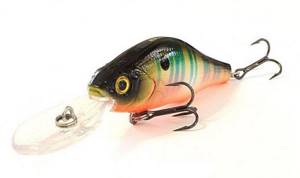
Kosadaka Mirage wobblers have three series: XS, XL and XD. Kosadaka Mirage XS wobblers have positive buoyancy, the length of the wobblers is 50, 70 and 85 mm, the weight of the wobblers is 4, 9 and 15.4 grams, respectively. The maximum depth of wobblers is from 0.8 to 1.5 meters. The XL series includes only one wobbler 5 cm long, weighing 4.2 grams, with a maximum depth of 0.8-1.5 meters. The XD series includes a 7 cm long wobbler, weighing 9.8 grams, with a maximum depth of 1.5-2.5 meters.
Wobbler Jackall Soul Shad
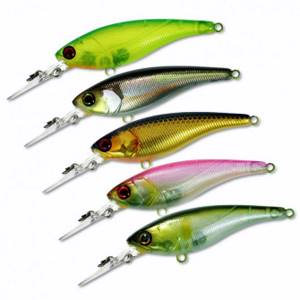
The Jackall Soul Shad wobbler, a new type of bait transitional between shad and minnow, is available in two sizes: 58 and 68 mm long, weighing 5 and 9.1 grams, respectively. The Jackall Soul Shad wobbler is a suspender. The color range of the wobbler includes 15 colors. Has a built-in long-casting system. The working depth of the Jackall Soul Shad wobbler is from 1 to 2 meters. The main objects for fishing with wobblers are pike and perch.
Wobbler Salmo Perch
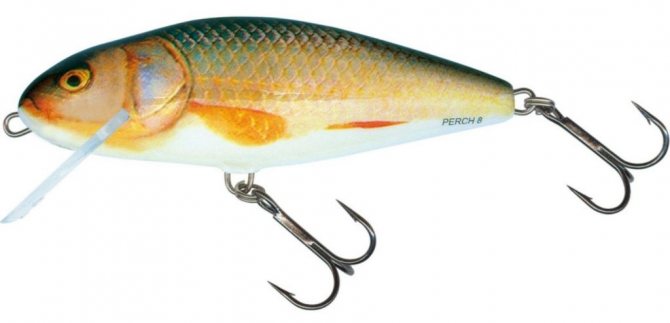
Wobbler Salmo Perch is a shad class wobbler from the famous Baltic company Salmo. The wobbler is available in three sizes: 8, 12 and 14 cm, in four modifications: F, SR, DR and SDR. The color palette of the wobbler is presented in 10 colors. Each wobbler model included in the Salmo Perch series has its own purpose. Models F and SR are designed for spinning fishing; the best wiring for them is twitching. DR and SDR models are good for trolling. Salmo Perch wobblers are designed for catching pike, but can be successfully used for catching perch, pike perch, and salmon.
Wobbler Tsuribito Super Shad

Wobbler Tsuribito Super Shad is a universal bait for fishing at medium depths. The wobbler has a bright and stable action, making it very catchy and allowing you to fish different depth horizons by changing the speed of the retrieve. The wobbler is floating, has a length of 60 or 75 mm, its weight is 6.5 or 11.5 grams, respectively, the working depth is 1.5-2.5 meters. The Tsuribito Super Shad wobbler is available in 16 different colors.
Wobbler ZipBaits Khamsin
Wobbler ZipBaits Khamsin is a shad wobbler from the world famous Japanese company ZipBaits. According to anglers, the wobbler’s appearance resembles an “emaciated crucian carp.” The wobbler is equipped with a long-distance casting system. The ZipBaits Khamsin wobbler is available in two modifications: SR and DR. The ZipBaits Khamsin SR wobbler has neutral buoyancy, the length of the wobbler is 70 mm, weight 9.5 grams, working horizon 1.0-1.5 meters. Wobbler ZipBaits Khamsin DR has neutral buoyancy, wobbler length is 70 mm, weight 10 grams, working horizon 1.5-2 meters.
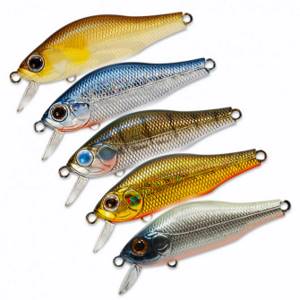
Wobblers are produced in large quantities, both natural colors and acidic colors, which allows the angler to choose a bait that is suitable in color for any fishing conditions. The objects of wobbler fishing are perch, pike and pike perch.
Review of the Jackall Soul Shad wobbler: a universal shad
When fishing with wobblers, I use different types of baits: minnows, cranks, poppers, topwaters. But I give special preference to shad-like baits, which I use in almost any conditions, covering the entire range of fishing. We will talk about one of these baits today. Jackall Soul Shad is a versatile shad that has been performing well for several years. Having caught different predators with it in different conditions, I would like to tell you in detail about all the secrets of this wobbler and the features of its use.
Jackall Soul Shad is available in three sizes: 45, 58, 68 mm. With neutral buoyancy, these options have varying degrees of depth, which allows them to completely cover the depth range from 0.6 to 2 meters. It's convenient and practical.
The wobbler sinks very quickly to the working depth. To achieve the maximum depth of wiring, after splashing down the wobbler, I make three or four smooth, extended jerks. During wiring, the wobbler maintains its depth and does not lose its play even in strong currents.
You can conduct a Soul Shed in different ways, it all depends on the predator you are going to hunt. For example, the night pike perch loves a leisurely, measured movement, but also cannot refuse soft stretches! In this case, Soul Shad performed particularly well. On a slow, even retrieve, the wobbler, due to its own high-frequency play, operates even at the lowest reel speeds, which is very helpful when catching a passive predator. I often use this wobbler in places with a barely noticeable current, where lures with a good game of their own, starting at low speeds, win. In addition, in these conditions, the recoil of the wobbler during a pause works well. The bait is caught by the current and slowly floats, swaying its barrels, which cannot leave any predator indifferent.
It happened that soft twitching also worked, but this was the case when the fish was active. Small and random impacts, during which the wobbler tacks, also provoke a predator.
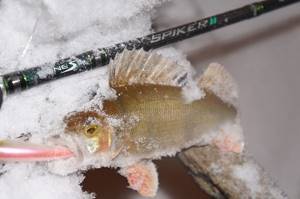
The smallest “Soul-shad”, 45 mm, has proven itself very well in catching perch. Weighty perches are not averse to eating this plump wobbler.
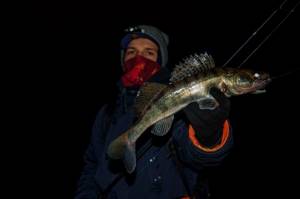
But large pike and pike-perch are no longer averse to feasting on sizes 58 and 68.
Often at night, the Soul Shad lifts a very passive pike perch from the depths, and pike also do not disdain it and often end up as bycatch.
Jackall Soul Shad also performed well on small rivers. I like to fish in winter on small rivers in the Moscow region, but it happens that because of snow or a steep bank it is not possible to get close to the water. In this case, Soul Shad comes to the rescue. Thanks to good depth and long flight range, it is possible to compensate for the height of the shore and conduct piloting even in places that at first glance seem inaccessible.
A few words about casting range. There is a ball in the body of the wobbler, which, when cast, moves through a special channel into the tail part of the bait, due to which the wobbler flies smoothly and far, reaching the target. Even when using PE #1.0 line, I don't lose any distance, but I'm always ready for a trophy. All “Soul Sheds” are equipped with powerful hooks that confidently catch fish and do not unbend when fishing.
To sum it up, I want to say that Jackall Soul Shad is a real lifesaver. The wobbler has a well-defined game of its own, easily provokes a predator, and its varied depth, rich color palette and effective system for increasing casting range make it a universal bait for different fishing conditions. The Soul Shad has found a place in my work box for both night-time walleye and pike fishing.
